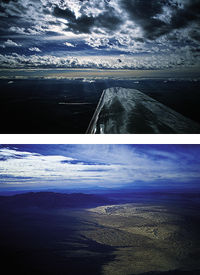10 COOL Winter Photo Tips
Maybe it's cold outside . . . but it's a great time to take pictures!
Winter brings with it some great photo opportunities. In many areas winter means snowy landscapes and snow sports; in others, it's just a somewhat cooler and slightly wetter time of year. Here are some winter-oriented photo tips that should help you add some nice shots to your portfolio, and have some fun doing it.
 1 Sun Comes Up, Sun Goes Down . . .
1 Sun Comes Up, Sun Goes Down . . .
If you're not an early riser, or you like to get to bed early, winter is your season for sunrises and sunsets. The sun rises nearly three hours later, and sets nearly three hours earlier, in mid-winter than it does in mid-summer. So you can sleep in and still catch those neat things that often happen around sunrise (such as the alpenglow on pre-sunrise lenticular clouds shown here)—or photograph the sunset and still have time to go out for dinner and a movie. You can also capture those sunsets over picturesque parklands that close at 5 or 6 p.m. (which is well before sunset in mid-summer). Photo by Mike Stensvold
 2 Different Times of Day
2 Different Times of Day
As the sun "travels across the sky" (which it does more quickly during the shorter days of winter), the lighting direction changes relative to landscape features. So, schedule permitting, you should check out potential subjects first thing in the morning, in midmorning, around noon, in midafternoon, in late afternoon, and around sunset to see how they look in the different lighting. Not only does the lighting direction change throughout the day, but the color changes as well, from cool before sunrise to warm just after sunrise to neutral at midday to warmer near sunset to cooler after sunset. The combination of different lighting angles and different lighting colors can make a subject look quite different as the Earth does its daily rotation. So shoot a frame (or more) throughout the day, and you'll get some interesting shots.Photo by Lynne Eodice
 3 White Is White
3 White Is White
. . . but snow isn't, always. Snow in sun is white, snow in shade is bluish, snow under an overcast sky is grayish, snow near sunrise or sunset has a warm cast. To get great snow shots, first you have to learn to see the snow as it is, and second you have to expose it properly. If you take a reading off sunlit snow with your camera's built-in reflected-light meter, the resulting photo will show the snow as gray—too dark for sunlit snow. So you'll have to give the snow more exposure than the meter calls for. How much more? That depends on how you want the snow to appear—try one stop, and bracket exposures. Soon you'll develop a "feel" for how to expose snow to show it the way you want in your photos. (Note: If the snow occupies only a small portion of the image, your in-camera meter will probably expose it correctly. But it's still a good idea to bracket exposure whenever you're in doubt. )Photo by Mike Stensvold
 4 A Touch of Color
4 A Touch of Color
Snow is very pretty, but photographically a little snow goes a long way. You can add interest and color to snow shots simply by including a colorful object or two in your composition. The colorful object can be incidental, or the main subject of the photo. Keep your eyes peeled for colorful items to include in your snow pictures.Photo by Ron Leach
 5 Enroute
5 Enroute
Getting there is half the fun, the old adage goes. And photos taken enroute to your winter destination can add interest to your slide show or portfolio. Keep an eye out for interesting formations you can include with the road as you drive toward your destination. Or photograph travel companions wending their way to the top.Photo by Ron Leach (top) and Lynne Eodice
 6 Seasonal Holidays
6 Seasonal Holidays
Several major holidays fall during winter, and each offers many photo opps. Have your camera ready, with lots of film and some spare batteries, and keep an eye out for colorful subject matter.Photo by Lynne Eodice
 7 Watch the Birdies
7 Watch the Birdies
Many birds fly south for the winter. So, if you live in the "south," you'll likely have lots of birds to photograph that you don't have during the rest of the year. Unfortunately, many of them are in their winter plumage, which isn't nearly as colorful as their breeding (generally spring-summer) plumage. But they still make good photo subjects and give your bird photos some variety. This past winter, we in Los Angeles enjoyed a large number of vacationing American White Pelicans.Photo by Mike Stensvold
 8 From Above
8 From Above
Clear winter days are generally pristine compared to "clear" summer days, as the winter storms temporarily remove pollution particles from atmosphere, and the cooler unstable winter air tends to provide better visibility than summer's warmer stable layers. The result is better photographic conditions for scenic and aerial photography, and any shots of distant subjects.Photo by Mike Stensvold
 9 Bare Flora
9 Bare Flora
Many plants lose their leaves for winter. So you can photograph branch patterns, something you can't do most of the year.Photo by Mike Stensvold (top) and Lynne Eodice
 10 Moonlight on Snow
10 Moonlight on Snow
Moonlit landscapes can be very effective, but they're at their best on snow. The white snow won't be white in the photo (it'll take on a bluish tint), but it will reflect the dim moonlight and give you a landscape image containing far more detail than you'd get with the moon lighting dark ground. For this shot, the camera was steadied on an ice-ax "monopod." Photo by Ron Leach
- Log in or register to post comments














































